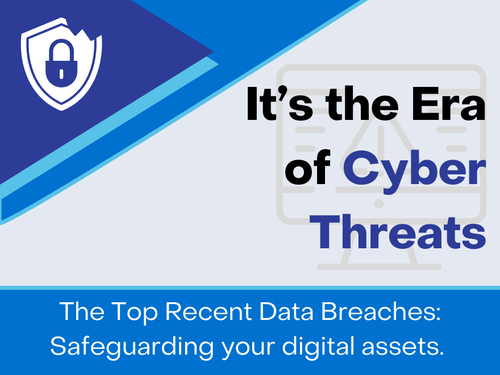
The Top recent data breaches: Safeguarding your digital assets in an era of cyber threats.
Due to the current digital world we live in, the battle against cyber threats is an ongoing challenge, and data compromises have surged to an all-time high. Data breaches in 2021 were 1,862; in 2023, that number was already over 2,100, continuing to rise through the new year.
So, what were the Top data compromises?
– HCA Healthcare
– Maximus
– The Freecycle Network
– IBM Consulting
– CareSource
– Duolingo
– PH Tech
This data underscores cybercriminals’ relentless efforts to exploit vulnerabilities and access sensitive information. Let’s take a look at the main drivers of this increase. And the urgent need for enhanced cybersecurity measures.

The Size of the Surge.
Data breaches have reached unprecedented levels, increasing significantly compared to previous measures. The scale and frequency of these incidents emphasise the evolving sophistication of cyber threats.
Ransomware reigns supreme.
Ransomware attacks continue to dominate the cybersecurity landscape. Cybercriminals are not merely after data. They are wielding the threat of encrypting valuable information and demanding ransom payments for release. The sophistication of ransomware attacks has increased. Threat actors are employing advanced tactics to infiltrate networks and encrypt data.
Supply chain vulnerabilities exposed.
Modern business ecosystems are interconnected, making supply chains a focal point for cyberattacks. The compromise of a single entity within the supply chain can have cascading effects, impacting several organisations downstream. Cybercriminals are exploiting these interdependencies. They use vulnerabilities to gain unauthorised access to a network of interconnected businesses.
Emergence of Insider Threats.
The rise of insider threats is adding a layer of complexity to cyber security. Insiders can inadvertently contribute to data breaches through malicious or unwitting intent/negligence. OrganisationsOrganisations need to distinguish between legitimate user activities and potential insider threats.
IoT Devices as Entry Points.
The proliferation of Internet of Things (IoT) devices has expanded the attack surface. There’s been an uptick in data breaches originating from compromised IoT devices. These connected endpoints range from smart home devices to industrial sensors. They are often inadequately secured, providing cyber criminals with entry points to exploit network vulnerabilities.
Critical infrastructure in the crosshairs.
Critical infrastructure has become a target choice for cyber attackers. This includes energy grids, water suppliers, and transportation systems. The potential consequences of a successful breach in these sectors are often financial. But that’s not all. They can also extend to public safety and national security. As cyber threats evolve, safeguarding critical infrastructure has become an urgent imperative.
Collaboration and Information Sharing.
Collaboration among organisations and information sharing within the cybersecurity community is critical. Especially as cyber threats become more sophisticated. Threat intelligence sharing enables a collective defence against shared adversaries. This allows organisations to fortify their defences proactively. They do this based on insights gained from the broader cybersecurity landscape.
Protect your business from devastating data breaches.
The current surge in data breaches reminds us of the evolving and persuasive nature of cyber threats. Robust cybersecurity solutions are definitely needed to ensure your business is proactive in defending itself.

Chat with our team today and build a cyber security plan to suit your needs.
